By Christine Peets
Walking is great exercise and by taking your Nordic Poles along, it can be more of a workout than just a walk in the park. I am the co-leader of a Nordic Pole Walking Group at the 55 Plus Activity Centre in Napanee, and have made some great friends. On a beautiful day in late October we decided to go to the Dunes Trail at Sandbanks.
Nordic Walking became popular in the 1980s fashioned after cross-country skiing, and first added as off-season training. Now Nordic Walking has become a sport unto itself. Adding the poles increases your cardiovascular rate, and makes stronger use of 90% of your muscles. The poles also had balance and stability and take the pressure away from joints, which makes walking easier, especially for those who may have some mobility issues. While all of those reasons for using the poles are important, I do it because it’s fun, and makes me feel like I’m really getting in a workout.

You’ll notice that we have different styles of poles. Most of us have Nordixx Walking Poles, each to our liking. As I’ve only used the Nordixx Poles, I can’t really comment on the other styles. One of the biggest differences with the Nordixx Poles is the hand-grip style wrist straps. These straps fit comfortably over your hand rather than wrapping around your wrist. You’ll notice that all of us in the photo have poles with straps, both styles. This article on the Nordixx Canada website explains why the wrist straps are necessary.
Here’s a better look at the Nordixx Walking Pole wrist strap:
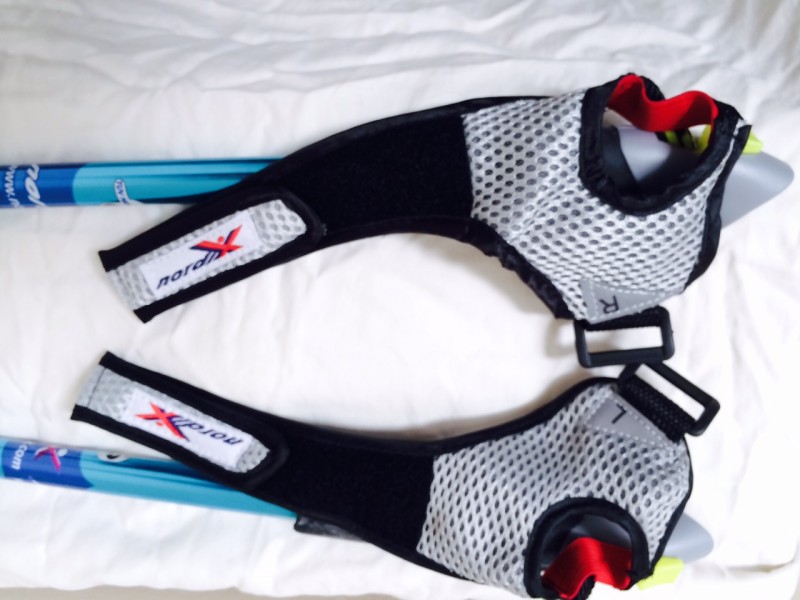
The Nordixx Global Traveler poles have detachable straps, which is convenient when you need to stop for a drink or snack, tie your shoe, or do anything else that requires your hands to be free. The Global Walker poles do not have this feature. They also do not collapse quite as small as the Traveler. I’ve used both, and have developed a preference for the Global Travelers. I like the detachable strap. Some people in my group prefer the wrap-around style. They find the Nordixx type of straps too warm in the summer and not well fitting over anything other than a thin glove in the colder weather. So, you have to decide when and how you’ll use the poles and which ones will work better for you.
You also need to consider your budget. Nordic Walking Poles can range from $50 to $150 per pair. Most are adjustable, but they may be in two or three sections, and adjust to different heights. Make sure that you purchase your poles from a reputable dealer, or at least from someone who knows how to fit and adjust the poles properly.
Here are the two styles from Nordixx Canada, which are sold through their distributors. You can find distributors, instructors, and walking groups in your area on the website.
- Nordixx Global Travelers
- Nordixx Global Walkers
Photo: Nordixx Canada
So, now that you’ve got your poles, it’s time to get out walking. Provincial parks are great because they have trails designed for all abilities. The poles provide stability and balance, on most surfaces, although on some of the narrower trails, or ones with a lot of rocks, you may find them cumbersome. I often take just one pole. As you noticed, for this trail, we all had both poles. It’s usually better to take both poles to make sure that you are well-balanced and supported.
The Sandbanks Dunes trail has two surfaces: crushed gravel on the accessible section, fine sand and boardwalks on the remainder of the trail. So our poles came in handy. The rubber “feet” on the poles could be removed for the softer sandy surface, but we chose to leave them on.
Here’s a description of the trail from the Sandbanks page on the Ontario Parks website:
Sandbanks Dunes Trail – 2.5 km loop, easy to moderate
This trail loops through a unique and fragile dune habitat and travels along the edge of several pannes. The dune system is the largest of its kind in the world and the pannes are a rare wetland habitat that supports wildlife and unusual flora.
In addition to the main trail, there is also a one-kilometre loop at the beginning of the trail that is barrier-free.
The barrier-free section has some information boards where you can learn more about the dunes.
We enjoyed the different elevations on the trail. As you get further on the trail, there are more small hills, so you have to be up to that challenge. There are valleys too, so you can stop for a rest.
Staying on the trail is important to minimize the impact on the dunes, and to avoid the Poison Ivy. I didn’t spot the ivy, but one of our group members did. I guess our recent frost wasn’t enough to kill it. So do be aware of your surroundings. When you want to take a good look at the trail, you can stop at this lookout.
With the shifting sands, we didn’t even really leave any footprints, or any that would last long, but it is important to remember not to leave any traces of your visit, and take only photographs. This is especially true in the off-season when comfort stations and eating areas are not open.
Sandbanks Provincial Park is one of the most popular and busiest parks during the summer months. Visiting in the off-season affords you the opportunity to do the trails at a more leisurely pace without the crowds, and to set your own pace. To find out the operating hours of Sandbanks, current weather and other information, check the website.
Hiking with Nordic Walking Poles makes this activity more fun and safer, especially for older adults who may experience difficulty with balance. Exploring the trails in our local provincial parks is something our group will continue—in all seasons.
Christine Peets enjoys Nordic Walking in parks and urban settings. She is a freelance writer and writing instructor. Visit her website for details: www.CaptionsCommunications.ca


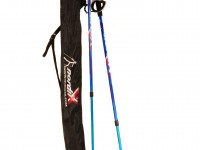
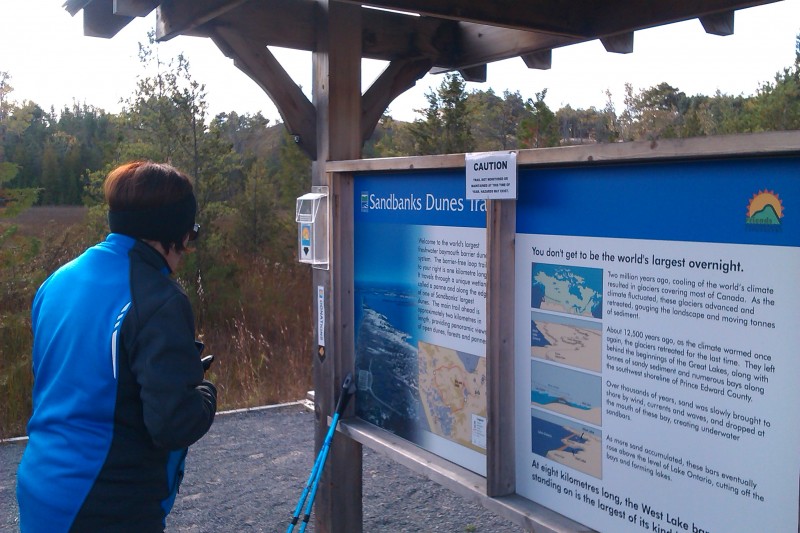
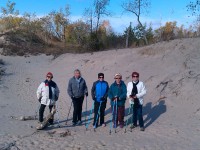
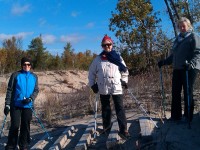
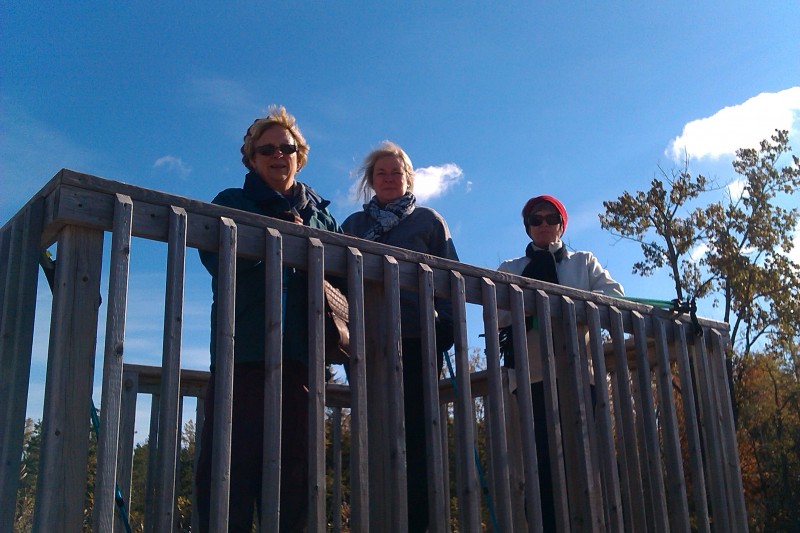
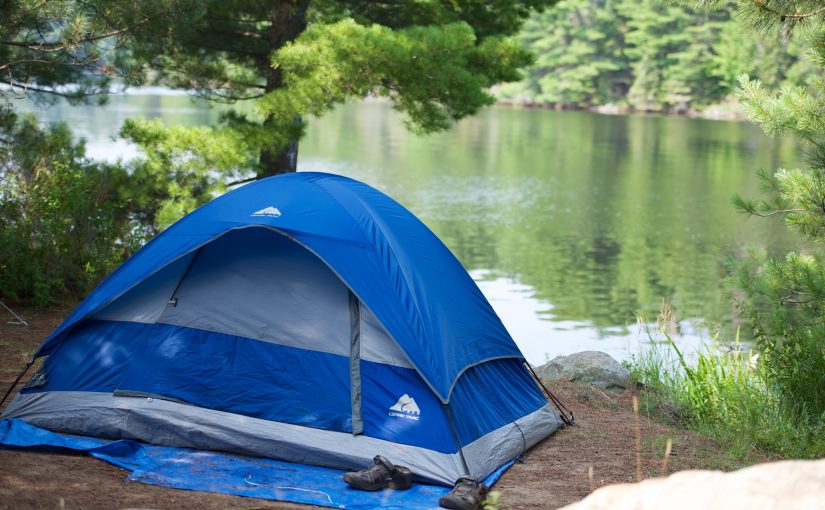

Great article, Christine. I’ve never understood the purpose of walking poles. Now I know!
Thanks, Judy.
Walking poles have been a great support to my knees and hips, and they are definitely good to have on the trails as they offer some balance and stability. It’s especially good as the leaves and ground can get slippery at this time of year.